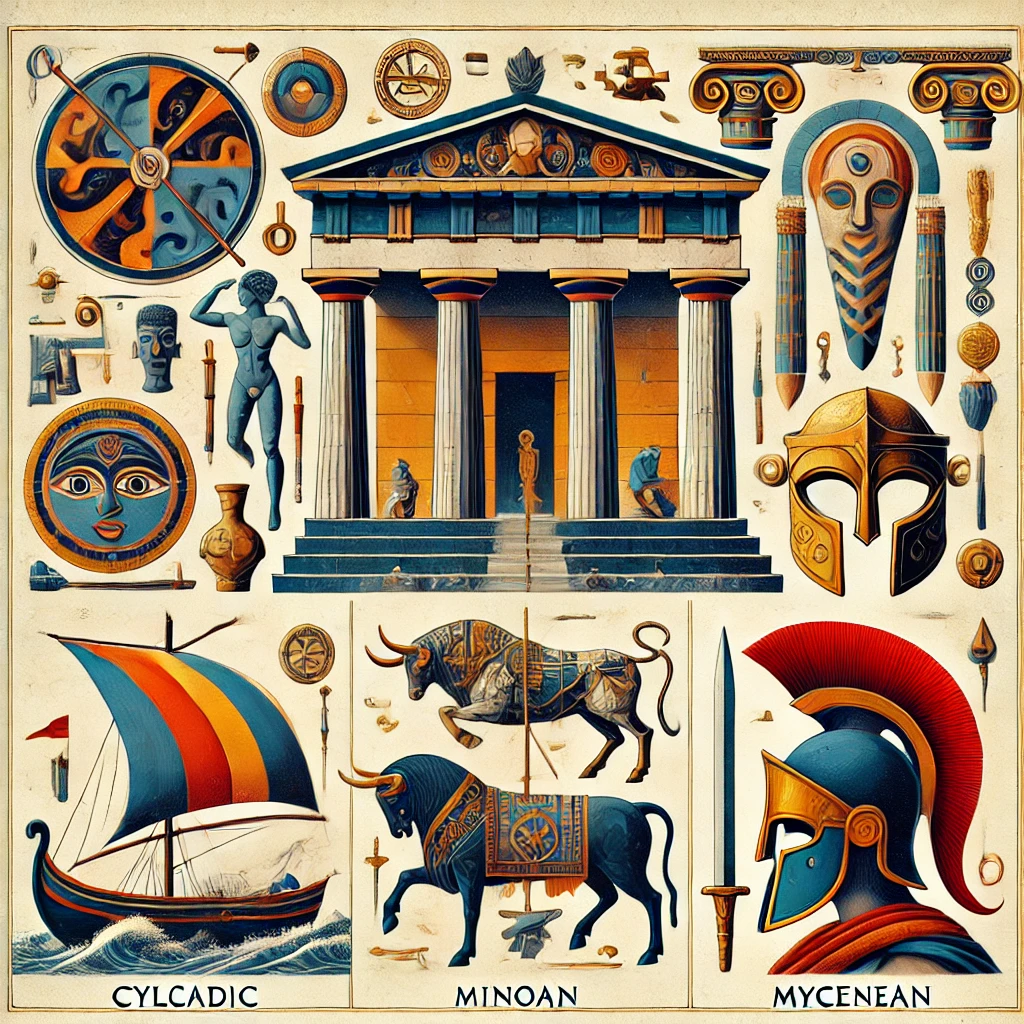The Aegean civilization is a fascinating blend of three antecedent cultures: the Minoan, Mycenaean, and Cycladic. Each of these cultures contributed to the rich tapestry of Aegean life, influencing everything from art and architecture to societal structures. Understanding the role these Aegean civilization antecedent cultures played provides a deeper insight into the early development of Western civilization. Join us as we explore the origins and contributions of these foundational societies.
Minoan Culture: The First Advanced Civilization in the Aegean
The Minoan culture stands as one of the most significant among the Aegean civilization antecedent cultures. Flourishing from around 2600 to 1400 BCE, the Minoans established a remarkable civilization on the island of Crete.
Key Features of Minoan Culture:
- Architecture: The Minoans built intricate palaces such as Knossos, characterized by multi-story structures, elaborate frescoes, and advanced plumbing systems.
- Economy: They thrived on trade, engaging in extensive maritime commerce with Egypt and the Near East, contributing significantly to their prosperity.
- Art: Known for their vibrant frescoes, intricate pottery, and impressive sculptures, Minoans displayed a high level of artistic achievement.
- Religion: The Minoans worshipped a pantheon of deities, predominantly goddesses, indicating a possibly matriarchal society. Ritual practices included bull-leaping and snake handling.
Moreover, the Minoans possessed a written script known as Linear A. Although this script remains undeciphered, it underscores the complexity and advancement of their society. Unlike the later Mycenaeans, Minoan culture did not emphasize military conquest, focusing instead on trade and diplomacy. Thus, the Minoans laid a foundation that influenced subsequent developments in the region, marking them as a crucial part of the Aegean civilization antecedent cultures.
Mycenaean Culture: The Rise of a Warrior Society
The Mycenaean culture, part of the Aegean civilization antecedent cultures, flourished from approximately 1600 to 1100 BCE. Renowned for their military prowess, the Mycenaeans left a significant imprint on subsequent Greek history.
Key Characteristics of Mycenaean Culture:
- Warrior Society: Mycenaeans built fortified palace complexes, reflecting their need for defense. King’s tombs, known as tholos or beehive tombs, often contained weapons and armor, indicating a warrior elite.
- Linear B Script: They utilized the Linear B script, an early form of Greek, mainly for record-keeping. This script offers valuable insights into their administrative and economic activities.
- Trade and Expansion: Mycenaeans engaged in extensive trade across the Mediterranean. They imported luxury goods and exported pottery and olive oil, facilitating cultural exchange.
Comparison of Aegean Antecedent Cultures:
| Culture | Key Features | Significance |
|---|---|---|
| Minoan | Advanced architecture, frescoes | Maritime trade, religious influence |
| Mycenaean | Military fortifications, Linear B | Warrior society, early Greek influence |
| Cycladic | Marble figurines, island settlements | Unique art and cultural expressions |
The Mycenaean culture, prominently one of the Aegean civilization antecedent cultures, exemplifies a society where warfare, trade, and early literacy intersected, leaving an enduring legacy on the classical world.
Cycladic Culture: The Art and Artifacts of an Island People
Among the Aegean civilization antecedent cultures, the Cycladic culture is particularly renowned for its distinctive art and artifacts. Flourishing around 3200 to 2000 BCE in the Cycladic Islands, this culture is famous for its unique marble sculptures, which often depict abstract human figures.
Key Features of Cycladic Art:
- Figurines: The most iconic artifacts are the marble figurines, typically representing nude female forms with folded arms. These sculptures are simple yet striking, characterized by their minimalist design.
- Materials and Techniques: Artisans primarily used local marble, employing techniques that highlighted the stone’s natural beauty.
- Functions: While the exact purpose remains debated, many scholars believe these figures had religious or ceremonial significance.
Comparative Analysis:
| Aspect | Minoan Culture | Cycladic Culture |
|---|---|---|
| Primary Material | Clay and metal | Marble |
| Art Style | Naturalistic and vibrant | Abstract and minimalist |
| Main Artifacts | Pottery and frescoes | Marble figurines |
Furthermore, Cycladic pottery and tools also provide insight into the daily life and trade practices of this island culture.
In conclusion, the Cycladic culture plays a significant role among the Aegean civilization antecedent cultures. Through their extraordinary art and artifacts, the Cycladic people left an indelible mark on archaeological history, aiding our understanding of early Aegean civilizations.
Frequently Asked Questions
What Are the Three Antecedent Cultures That Comprise Aegean Civilization?
The three antecedent cultures that comprise Aegean civilization are the Cycladic, Minoan, and Mycenaean civilizations. Each of these cultures contributed uniquely to the development of what we recognize today as Aegean civilization, flourishing in different regions and time periods within the Aegean Sea area.
Where Were the Cycladic People Located?
The Cycladic people were located in the Cyclades, a group of islands in the central Aegean Sea. This culture is one of the earliest in the region, known for their distinctive marble figurines, pottery, and their role as intermediaries between the mainland and other Aegean cultures.
Who Were the Minoans and What Is Their Significance?
The Minoans were an ancient civilization that emerged on the island of Crete. They are significant for their contributions to architecture, art, and trade within the Aegean and beyond. The Minoans developed an early form of writing known as Linear A and are often remembered for their elaborate palaces, most famously the palace at Knossos.
How Did the Mycenaean Civilization Influence Later Greek Culture?
The Mycenaean civilization, which flourished on mainland Greece, is considered a precursor to the classical Greek culture. They are known for their fortified palace complexes, their script known as Linear B (an early form of Greek), and their extensive trade networks. Many aspects of Mycenaean culture, from their mythology to their political organization, influenced later Greek civilization, including the Homeric epics which are based on Mycenaean legends and history.


